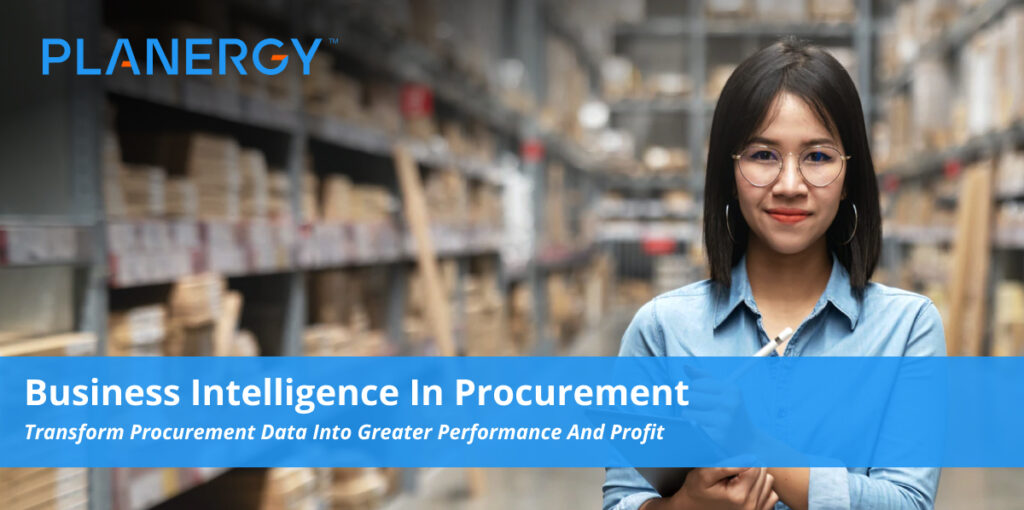With procurement organizations taking center stage as strategic value engines for the enterprises they support, putting business intelligence to good use in procurement is no longer optional for organizations who want to grow and compete effectively.
Procurement professionals are no longer merely holders of the purse strings, but custodians of business-critical information that can be used to improve all areas of an organization.
Finding ways to incorporate information from diverse data sources and using analytical tools to harvest insights from it can be challenging.
But with the right tools and a clear understanding of the role of business intelligence in procurement, you can organize, manage, and analyze your data to drive process improvements, build value, and support organizational goals for profitability, growth, and competitive advantage.
The Importance of Business Intelligence in Procurement
With each passing year, procurement data makes up a larger share of the Big Data used by organizations to craft strategies, improve risk management, and streamline workflows. 2021 research conducted by Ardent Partners found 62% of procurement organizations surveyed were using procurement analytics to create and execute sourcing strategies, with 55% providing significant guidance in enterprise-level decision making.
A full 46% of organizations surveyed by Ardent Partners already have a strategy in place for leveraging Big Data.
But as procurement takes a more central role, it’s crucial for procurement professionals to expand their data management capabilities and find ways to make the procurement function not just a source of iterative improvements, but the fully integrated nexus of data analytics, collaboration, and communication for their entire organizations.
In order to make this happen, it’s important for both chief procurement officers (CPOs) and the procurement teams they lead to understand what business intelligence in procurement—commonly referred to as procurement intelligence—actually is—and what it isn’t.
Procurement intelligence is holistic; it provides insights used to address a wide range of needs, including cost savings, cost avoidance, value creation, risk management, strategic sourcing, and more.
Key Aspects of Procurement Intelligence
Let’s take a look at the most important aspects of procurement intelligence as it’s being used today.
- Procurement intelligence is complex and relies on digital technologies to succeed. One way companies can establish a foundation for both procurement intelligence and organization-wide digital transformation is to implement a purpose-built procure-to-pay optimization solution with business intelligence capabilities, such as PLANERGY.
With cloud-based, centralized data management, advanced artificial intelligence (including robotic process automation powered by machine learning) and powerful analytics, a best-in-class solution will provide all the digital tools necessary to collect, organize, analyze, and use business intelligence effectively.
The primary benefit is data quality, as high-quality, complete procurement data is essential to effective analysis in all areas. A top-shelf P2P with BI tools accomplishes this through:- Full transparency into spend processes.
- Better control over actual spend through automation and internal controls such as guided buying and contract management integration, eliminating rogue spend and invoice fraud.
- Standardization and integration of the software environment and diverse data sources. Data silos are destroyed, information is available for role-appropriate access and analysis in real time, and teams can collaborate and communicate much more effectively because they all have the same information to work from, in the same formats.
- Intuitive and user-friendly dashboards for reporting, forecasting, budgeting, and more.
- Procurement intelligence is the collection and application of insights drawn from analysis of procurement data blended with other relevant information from other sources.
- Procurement intelligence is holistic; it provides insights used to address a wide range of needs, including cost savings, cost avoidance, value creation, risk management, strategic sourcing, and more.
- Procurement intelligence is defined by:
- Clean, high-quality data from a variety of sources. To get useful insights, procurement organizations need business intelligence made up of clean, relevant information from reliable data sources. In procurement, business intelligence includes more than just a company’s own procurement data. It incorporates market research (also called market intelligence), risk management data related to the supply chain, and more esoteric sources that can impact financial planning and sourcing strategies, such as social media activity, consumer trends, and changes in government and industry regulations.
- A variety of powerful procurement analytics to provide context and utility, including:
- Spend analytics.
- Contract analytics.
- Contract compliance analytics.
- Purchase order compliance analytics.
- Invoicing compliance analytics.
- Supply chain analytics.
- Financial modeling.
- Benchmarking supported by key performance indicators (KPIs) to measure performance and compliance metrics for internal processes, supplier management, and comparative performance within an industry or business sector.
- Procurement intelligence is flexible and agile. It provides insights that are not only useful, but delivered in a timely fashion to allow for maximum strategic value. Using performance KPIs, for example, can allow procurement professionals to monitor supplier compliance, purchase order cycle times, logistical errors, etc. in real time and take action to minimize waste and expense.
- Procurement intelligence is supplementary to, and not a replacement for, human intelligence and creativity. Procurement analytics can harvest invaluable insights from high-quality data, but it’s still up to humans to apply them to optimal effect.
Core Benefits of Business Intelligence in Procurement
The digital tools that power procurement intelligence provide several benefits that help companies meet their goals for growth and performance, preserve business continuity, and innovate with new products and services.
1. Ready access to high-quality, relevant information.
BI solutions integrate an organization’s data streams, help teams prioritize data transparency and completeness, and provide comprehensive data management in a single centralized source.
Their data management tools ensure procurement teams have all the information they need to create useful, user-friendly visualizations, reports, forecasts, and budgets, as well as monitor important processes and compliance in real time.
2. Improved Process Optimization and Resource Management
Thanks to advanced data management and categorization capabilities, procurement intelligence supports direct improvement of key procurement processes and helps companies make optimal use of their available resources.
For example, category managers can monitor all of the goods and services in their particular area of expertise, tracking not just historical spend but external information such as market intelligence.
A shortage or glut of raw materials used to make an essential component, for example, could signal an opportunity to stock up at a lower price before the shortage hits or negotiate better pricing and terms with favored vendors when there’s an excess.
Full data transparency and process automation also allow procurement teams to fully automate routine purchasing based on pre-established replenishment protocols, eliminating the need for human intervention while ensuring inventory levels are at the proper levels.
Supply chain resilience can also be improved with effective application of BI insights. By allowing procurement teams to track supplier performance, market trends, and potential business disruptors such as international conflict, global pandemics, or natural disasters, procurement intelligence can be used to build strategic sourcing contingencies into the company’s supply chain.
This ensures a steady flow of materials, goods, and services through targeted redundancies, use of local suppliers, etc, improving risk management even further.
Leverage Procurement Intelligence for Value and Performance
Invest in a comprehensive procure-to-pay solution. Make smart use of artificial intelligence, process automation, and analytics.
And most importantly, take a comprehensive, collaborative approach to collecting, analyzing, and leveraging procurement intelligence.
You’ll help center your procurement function as a source of strong support for enterprise goals and lasting value while improving collaboration, boosting profitability, and driving process improvements throughout your organization.




